Age and Origin of Silicocarbonate Pegmatites of the Adirondack Region
Abstract
1. Introduction and Geological Setting
2. Samples and Analytical Methods
2.1. Field Relations of Samples
2.2. U–Pb Zircon Geochronology and Trace-Element Analysis
2.3. Carbon and Oxygen Isotopic Analysis of Calcite
3. Results
3.1. U–Pb Zircon Geochronology
3.1.1. Lowlands Geochronological Samples
3.1.2. Highlands Geochronological Samples
3.1.3. Geochronological Samples Collected along the Carthage–Colton Shear Zone (from SW to NE)
3.1.4. Geochronological Samples Collected within the Carthage-Colton Shear Zone
3.2. Rare-Earth Elements in Zircon
3.3. Carbon and Oxygen Isotopes in Calcite
4. Discussion
4.1. Age of the Silicocarbonate Pegmatites
4.2. Origin of the Silicocarbonate Pegmatites
4.3. Tectonic Implications
5. Conclusions
Supplementary Materials
Author Contributions
Funding
Acknowledgments
Conflicts of Interest
Appendix A Analytical Procedures
References
- Ellsworth, H.V. Rare-Earth Minerals of Canada; Department of Mines: Ottawa, ON, Canada, 1932; Volume 11, pp. 1–272.
- Lumbers, S.B.; Heaman, L.M.; Vertolli, V.M.; Wu, T.-W. Nature and timing of Middle Proterozoic magmatism in the Central Metasedimentary Belt, Grenville Province, Ontario. In Mid-Proterozoic Laurentia-Baltica; Gower, C.F., Rivers, T., Ryan, B., Eds.; Geological Association of Canada: Ottawa, ON, Canada, 1990; Special Paper 38; pp. 243–278. [Google Scholar]
- Moecher, D.P.; Anderson, E.D.; Cook, C.A.; Mezger, K. The petrogenesis of metamorphosed carbonatites in the Grenville Province, Ontario. Can. J. Earth Sci. 1997, 34, 1185–1201. [Google Scholar] [CrossRef]
- Joyce, D.K. Calcite vein-dikes of the Grenville geological province. Rocks Miner. 2006, 81, 34–42. [Google Scholar] [CrossRef]
- Moyd, L. Davis Hill near Bancroft Ontario: An occurrence of large nepheline, biotite, albite-antiperthite crystals in calcite cored vein-dykes. Min. Record 1990, 21, 235–245. [Google Scholar]
- Lentz, D.R. Late-tectonic U–Th–Mo-REE skarn and carbonatitic vein-dyke systems in the south-western Grenville Province: A pegmatite-related pneumatolytic model linked to marble melting. In Mineralized Intrusion-related Skarn Systems; Lentz, D.R., Ed.; Mineralogical Association of Canada: Ottawa, ON, Canada, 1998; Short Course; Volume 26, pp. 519–657. [Google Scholar]
- Lentz, D. Carbonatite genesis: A reexamination of the role of intrusion-related pneumatolytic skarn processes in limestone melting. Geology 1999, 20, 335–338. [Google Scholar] [CrossRef]
- Sinaei-Esfahani, F. Localized Metasomatism of Grenvillian Marble Leading to its Melting, Autoroute 5 near Old Chelsea, Quebec. Master’s Thesis, McGill University, Montreal, QC, Canada.
- Schumann, D.; Martin, R.; de Fourestier, J.; Fuchs, S. Silicocarbonatite melt inclusions in fluorapatite from Otter Lake (Quebec): Evidence of carbonate melts in the Central Metasedimentary Belt of the Grenville Province. In Proceedings of the GAC-MAC Kingston 2017, Kingston, ON, Canada, 14–18 May 2017; p. 337. [Google Scholar]
- Robinson, G.W.; Chiarenzelli, J.R.; Bainbridge, M. Minerals of the Grenville Province—New York, Ontario, and Quebec; Schiffer Publishing Ltd.: Atglen, PA, USA, 2019; p. 207. [Google Scholar]
- Isachsen, Y.W.; Fisher, D. Geological Map of New York, Adirondack Sheet; New York State Museum and Science Service: Albany, NY, USA, 1970; scale 1:125,000. [Google Scholar]
- Chiarenzelli, J.; Kratzmann, D.; Selleck, B.; deLorraine, W. Age and provenance of Grenville Supergroup rocks, Trans-Adirondack Basin, constrained by detrital zircons. Geology 2015, 43, 183–186. [Google Scholar] [CrossRef]
- Chiarenzelli, J.; Selleck, B. Bedrock geology of the Adirondack Region. Adiron. J. Env Stud. 2016, 21, 19–42. [Google Scholar]
- Chiarenzelli, J.R.; Lupulescu, M.V.; Regan, S.P.; Singer, J.W. Age and Origin of the Mesoproterozoic Iron Oxide-Apatite Mineralization, Cheever Mine, Eastern Adirondacks, NY. Geosciences 2018, 8, 345. [Google Scholar] [CrossRef]
- Jaffe, H.W.; Jaffe, E.B.; Ollila, P.W.; Hall, L.M. Bedrock Geology of the High Peaks Region, Marcy Massif, Adirondacks, New York; University of Massachusetts: Amherst, MA, USA, 1983; p. 79. [Google Scholar]
- Chamberlain, S.C.; Robinson, G.W.; Walter, M.; Chiarenzelli, J.R. Collector’s Guide to the Black Tourmaline of Pierrepont, New York; Schiffer Publishing Ltd.: Atglen, PA, USA, 2016; p. 128. [Google Scholar]
- Brown, C.E. Mineralization, Mining, and Mineral Resources in the Beaver Creek Area of the Grenville Lowlands in St. Lawrence County, New York; United States Geological Survey: Washington, DC, USA, 1983; professional paper 1279; p. 21.
- Sutherland, A.; Sutherland, S.; Robinson, G.W.; Lupulescu, M.V.; Bailey, D.G.; Chamberlain, S.C. New danburite locality discovered in the Town of Macomb, St. Lawrence County, New York. Rocks Miner. 2017, 92, 180–187. [Google Scholar] [CrossRef]
- Shepard, C.U. On a Supposed New Mineral Species. Am. J. Sci. Art. 1840, 39, 357–360. [Google Scholar]
- Chamberlain, S.; Robinson, G.; Smith, C. The occurrence of wollastonite and titanite Natural Bridge, Lewis County, New York. Rocks Miner. 1987, 62, 78–89. [Google Scholar] [CrossRef]
- Robinson, G.W.; Chamberlain, S.C. Gazetteer of Major New York State Mineral Localities. Rocks Miner. 2007, 82, 472–483. [Google Scholar] [CrossRef]
- Chamberlain, S.C.; Robinson, G.W.; Robinson, S.; Walter, M.R.; Bailey, D.G.; Chiarenzelli, J.R.; Lupulescu, M.V. The Rose Road Localities, Town of Pitcairn, St. Lawrence County, New York: Part 1-History. Rocks Miner. 2018, 93, 442–453. [Google Scholar] [CrossRef]
- Brush, G.J.; Dana, E.S. On crystallized danburite from Russell, St. Lawrence County, New York. Am. J. Sci. 1880, 120, 111–118. [Google Scholar] [CrossRef]
- Chamberlain, S.C.; Lupulescu, M.V.; Bailey, D.G. The Classic Danburite Occurrence Near Russell, St. Lawrence County, New York. Rocks Miner. 2015, 90, 212–223. [Google Scholar] [CrossRef]
- Chamberlain, S.C.; Robinson, G.W.; Robinson, S.; Walter, M.R.; Bailey, D.G. The Selleck Road Tremolite and Tourmaline Locality, West Pierrepont, St. Lawrence County, New York. Rocks Miner. 2016, 91, 116–131. [Google Scholar] [CrossRef]
- Miller, W.J. Some crystal localities in St. Lawrence County, New York. Am. Min. 1921, 6, 77–79. [Google Scholar]
- Toraman, E.; Chiarenzelli, J. The longevity of the Carthage-Colton shear zone: Insights for multiphase U–Pb geochronology, Ti Thermochronology, and trace-element geochemistry. In Proceedings of the 54th Annual GSA Northeastern Section Meeting, Portland, ME, USA, 17–19 March 2019. [Google Scholar] [CrossRef]
- Grimes, C.B.; John, B.E.; Kelemen, P.B.; Mazdab, F.K.; Wooden, J.L.; Cheadle, M.J.; Hanghøj, K.; Schwartz, J.J. Trace-element chemistry of zircons from oceanic crust: A method for distinguishing detrital zircon provenance. Geology 2007, 35, 643–646. [Google Scholar] [CrossRef]
- Sun, S.S.; McDonough, W.F. Chemical and isotopic systematics of oceanic basalts; implications for mantle composition and processes. In Magmatism in the Ocean Basins; Saunders, A.D., Norry, M.J., Eds.; Geological Society of London: London, UK, 1989; pp. 313–345. [Google Scholar]
- Kitchen, N.E.; Valley, J. Carbon isotope thermometry in marbles of the Adirondack Mountains, New York. J. Metamorph. Geol. 1995, 13, 577–594. [Google Scholar] [CrossRef]
- Whelan, J.F.; Rye, R.O.; De Lorraine, W.; Ohmoto, H. Isotopic geochemistry of a mid-Proterozoic evaporite basin: Balmat, New York. Am. J. Sci. 1990, 290, 396–424. [Google Scholar] [CrossRef]
- Ye, H.-M.; Li, X.-H.; Lan, Z.-W. Geochemical and Sr–Nd–Hf–O–C isotopic constraints on the origin of the Neoproterozoic Qieganbulake ultramafic–carbonatite complex from the Tarim Block, Northwest China. Lithos 2013, 182–183, 150–164. [Google Scholar] [CrossRef]
- McLelland, J.; Chiarenzelli, J.; Whitney, P.; Isachsen, Y. U–Pb zircon geochronology of the Adirondack Mountains and implications for their geologic evolution. Geology 1988, 16, 920–924. [Google Scholar] [CrossRef]
- Lupulescu, M.; Chiarenzelli, J.; Pullen, A.; Price, J. Using pegmatite geochronology to constrain temporal events in the Adirondack Mountains. Geosphere 2011, 7, 23–39. [Google Scholar] [CrossRef]
- Chiarenzelli, J.; Selleck, B.; Lupulescu, M.; Regan, S.; Bickford, M.E.; Valley, P.; McLelland, J. Lyon Mountain Ferroan Leucogranite Suite: Response to Collision, Thickened Crust, and Extension in the Core of the Grenville Orogen. Geol. Soc. Am. Bull. 2017, 129, 1472–1488. [Google Scholar]
- Selleck, B.W.; Peck, W.H.; McLelland, J.M.; Bergman, M.; Ellis, A.; Conti, C. Late Ottawan (ca. 1035 Ma) hydrothermal signatures in the southeastern Adirondack Lowlands: New geochronological, stable isotope, and fluid inclusion results. In Proceedings of the Northeastern Section-43rd Annual Meeting, Buffalo, NY, USA, 27–29 March 2008. [Google Scholar]
- McLelland, J.; Selleck, B. Megacrystic Gore Mountain–type garnets in the Adirondack Highlands: Age, origin, and tectonic implications. Geosphere 2011, 7, 1194–1208. [Google Scholar] [CrossRef]
- Baumgartner, L.P.; Valley, J.W. Stable Isotope Transport and Contact Metamorphic Fluid Flow; Valley, J.W., Cole, D.R., Eds.; Mineralogical Society of America: Chantilly, VA, USA, 2001; Volume 43, pp. 415–468. [Google Scholar]
- Dickin, A.P.; McNutt, R.H. The Central Metasedimentary Belt (Grenville Province) as a failed back-arc rift zone: Nd isotope evidence. Earth Planet. Sci. Lett. 2007, 259, 97–106. [Google Scholar] [CrossRef]
- McLelland, J.; Morrison, J.; Selleck, B.; Cunningham, B.; Olson, C.; Schmidt, K. Hydrothermal alteration of late- to post-tectonic Lyon Mountain granitic gneiss, Adirondack Mountains, New York: Origin of quartz-sillimanite segregations, quartz–albite lithologies, and associated Kiruna-type low Ti–Fe–oxide deposits. J. Metamorph. Geol. 2002, 20, 175–190. [Google Scholar] [CrossRef]
- Selleck, B.W.; McLelland, J.; Bickford, M.E. Granite emplacement during tectonic exhumation: The Adirondack example. Geology 2005, 33, 781–784. [Google Scholar] [CrossRef]
- Valley, P.M.; Hanchar, J.M.; Whitehouse, M.J. Direct dating of Fe oxide–(Cu–Au) mineralization by U/Pb zircon geochronology. Geology 2009, 37, 223–226. [Google Scholar] [CrossRef]
- Bonamici, C.E.; Kozdon, R.; Ushikubo, T.; Valley, J.W. High-resolution P-T-t paths from δ18O zoning in titanite: A snapshot of late-orogenic collapse in the Grenville of New York. Geology 2011, 39, 959–962. [Google Scholar] [CrossRef]
- Bonamici, C.E.; Kozdon, R.; Ushikubo, T.; Valley, J.W. Intragrain oxygen isotope zoning in titanite by SIMS: Cooling rates and fluid infiltration along the Carthage-Colton Mylonite Zone, Adirondack Mountains, NY, USA. J. Meta. Geol. 2014, 32, 71–92. [Google Scholar] [CrossRef]
- Regan, S.P.; Walsh, G.J.; Williams, M.L.; Chiarenzelli, J.R.; Toft, M.; McAleer, R. Syn-collisional exhumation of hot middle crust in the Adirondack Mountains (New York, USA): Implications for extensional orogenesis in the southern Grenville province. Geosphere 2019, 15, 1–22. [Google Scholar] [CrossRef]
- Valley, P.M.; Fisher, C.; Hanchar, J.; Lam, R.; Tubrett, M. Hafnium isotopes in zircon: A tracer of fluid-rock interaction during magnetite–apatite (“Kiruna-type”) mineralization. Chem. Geol. 2010, 275, 208–220. [Google Scholar] [CrossRef]
- McLelland, J.; Hamilton, M.; Selleck, B.; McLelland, J.M.; Walker, D.; Orrell, S. Zircon U–Pb geochronology of the Ottawan Orogeny, Adirondack Highlands, New York: Regional and tectonic implications. Precambrian Res. 2001, 109, 39–72. [Google Scholar] [CrossRef]
- Heumann, M.J.; Bickford, M.E.; Hill, B.M.; Selleck, B.W.; Jercinovic, M.J. Timing of anatexis in metapelites from the Adirondack Lowlands and Southern Highlands: A manifestation of the Shawinigan Orogeny and subsequent anorthosite–mangerite–charnockite–granite (AMCG) magmatism. Geol. Soc. Am. Bull. 2006, 118, 1283–1298. [Google Scholar] [CrossRef]
- Valentino, D.W.; Chiarenzelli, J.R.; Regan, S.P. Spatial and temporal links between Shawinigan accretionary orogenesis and massif anorthosite intrusion, southern Grenville province, New York, USA. J. Geodyn. 2019, 129, 80–97. [Google Scholar] [CrossRef]
- Rivers, T. The Grenville Province as a large hot long-duration collisional orogeny-insights from the spatial and thermal evolution of its orogenic fronts. Geol. Soc. Lond. Spec. Publ. 2009, 327, 405–444. [Google Scholar] [CrossRef]
- Gehrels, G.E.; Valencia, V.; Ruiz, J. Enhanced precision, accuracy, efficiency, and spatial resolution of U–Pb ages by laser ablation-multicollector inductively coupled plasma-mass spectrometry. Geochem. Geophys. 2008, 9, 1–13. [Google Scholar] [CrossRef]
- Stacey, J.S.; Kramers, J.D. Approximation of terrestrial lead isotope evolution by a two-stage model. Earth Planet. Sci. Lett. 1975, 26, 207–221. [Google Scholar] [CrossRef]
- Ludwig, K. Isoplot 3.7 and 4.1. Berkeley Geochronology Center BGC, 2008. Available online: http://www.bgc.org/isoplot_etc/isoplot.html (accessed on 9 September 2018).
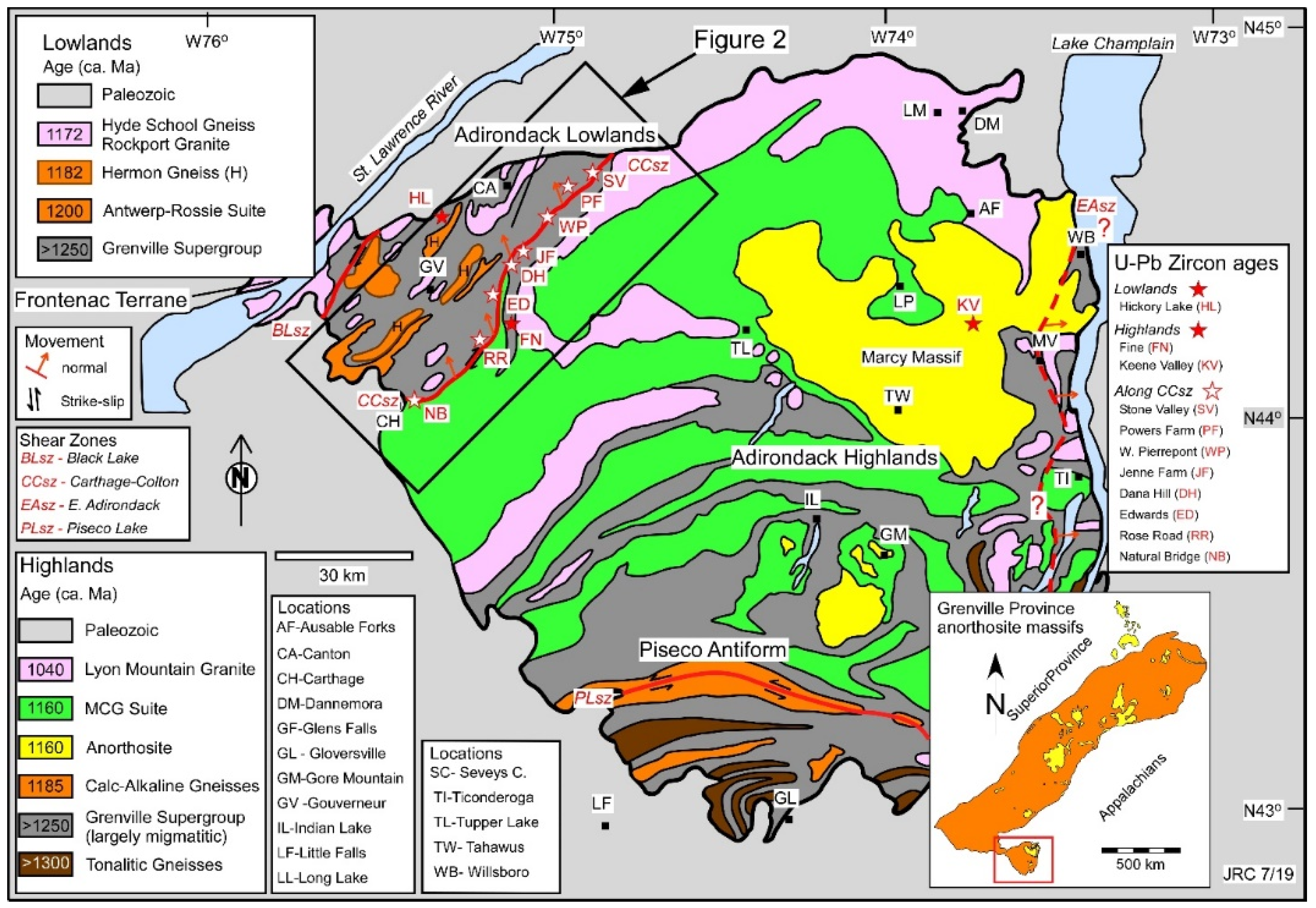

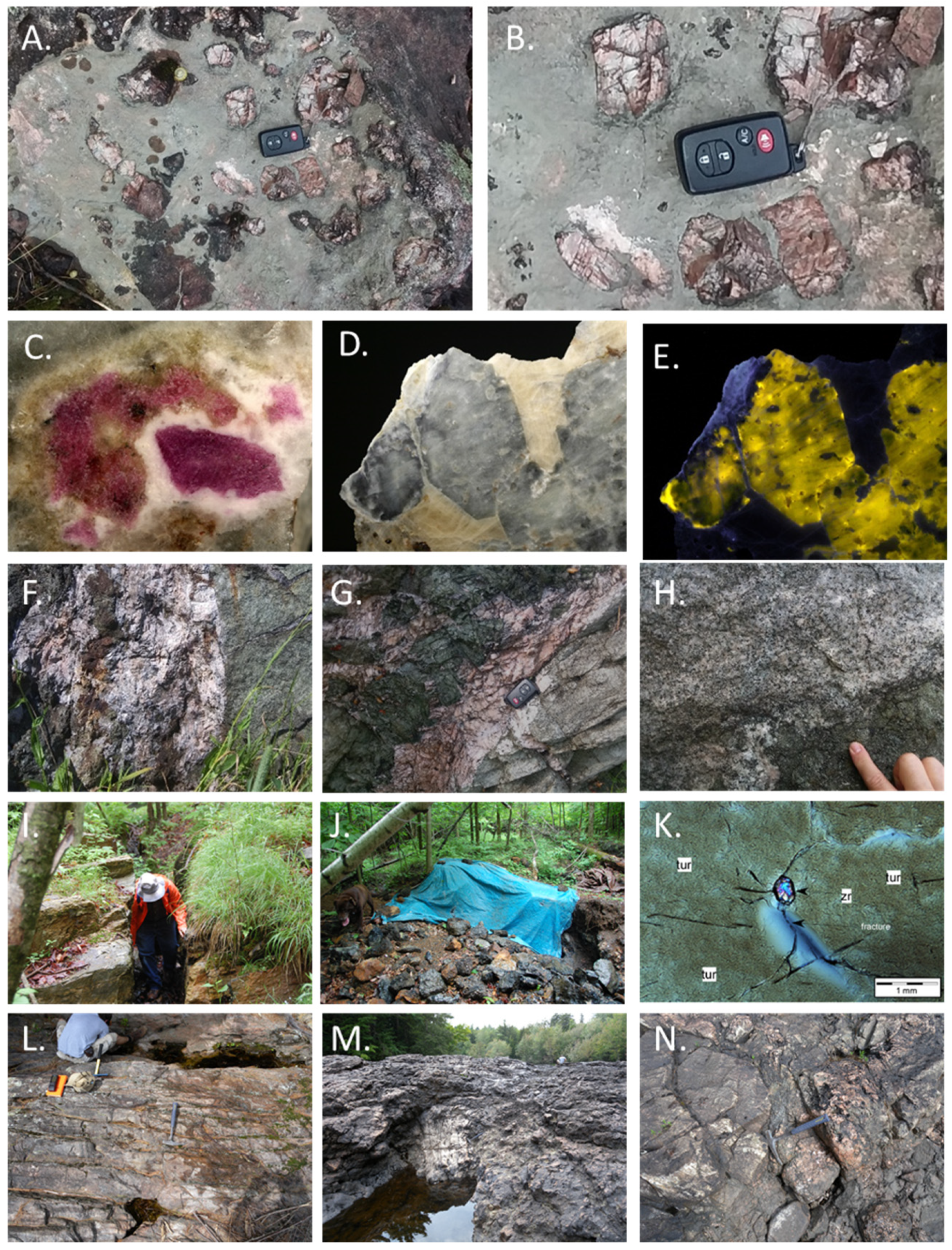
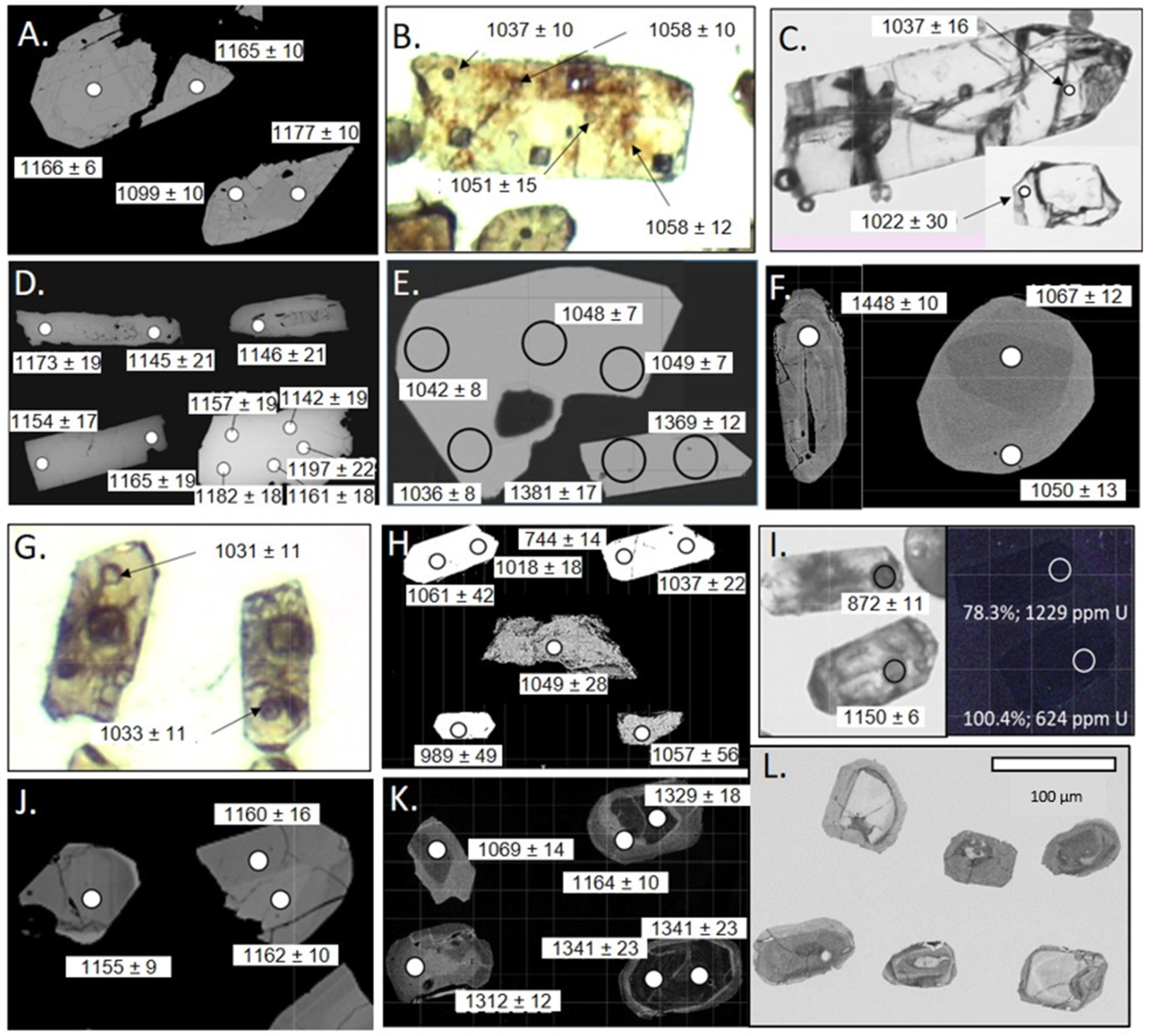
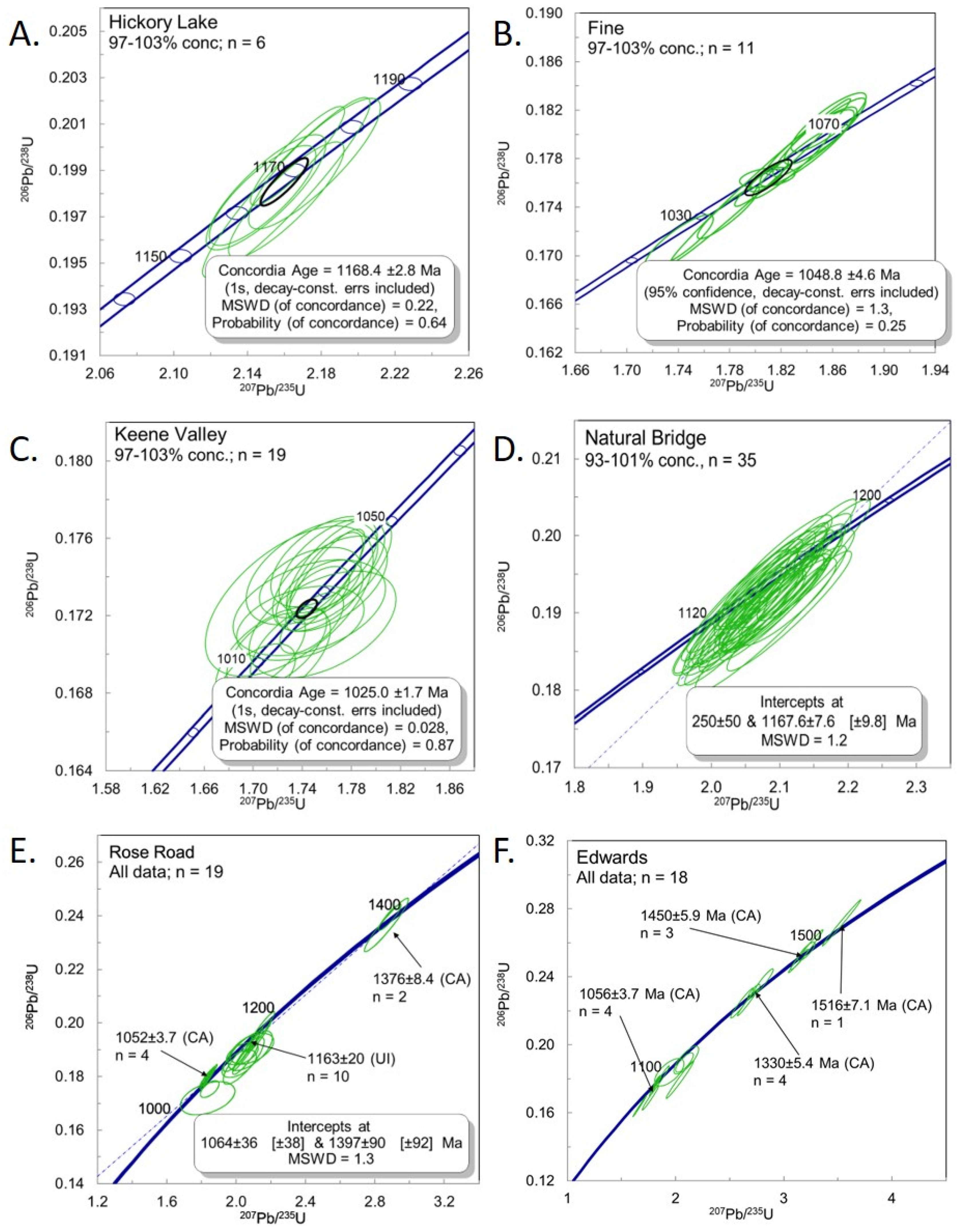
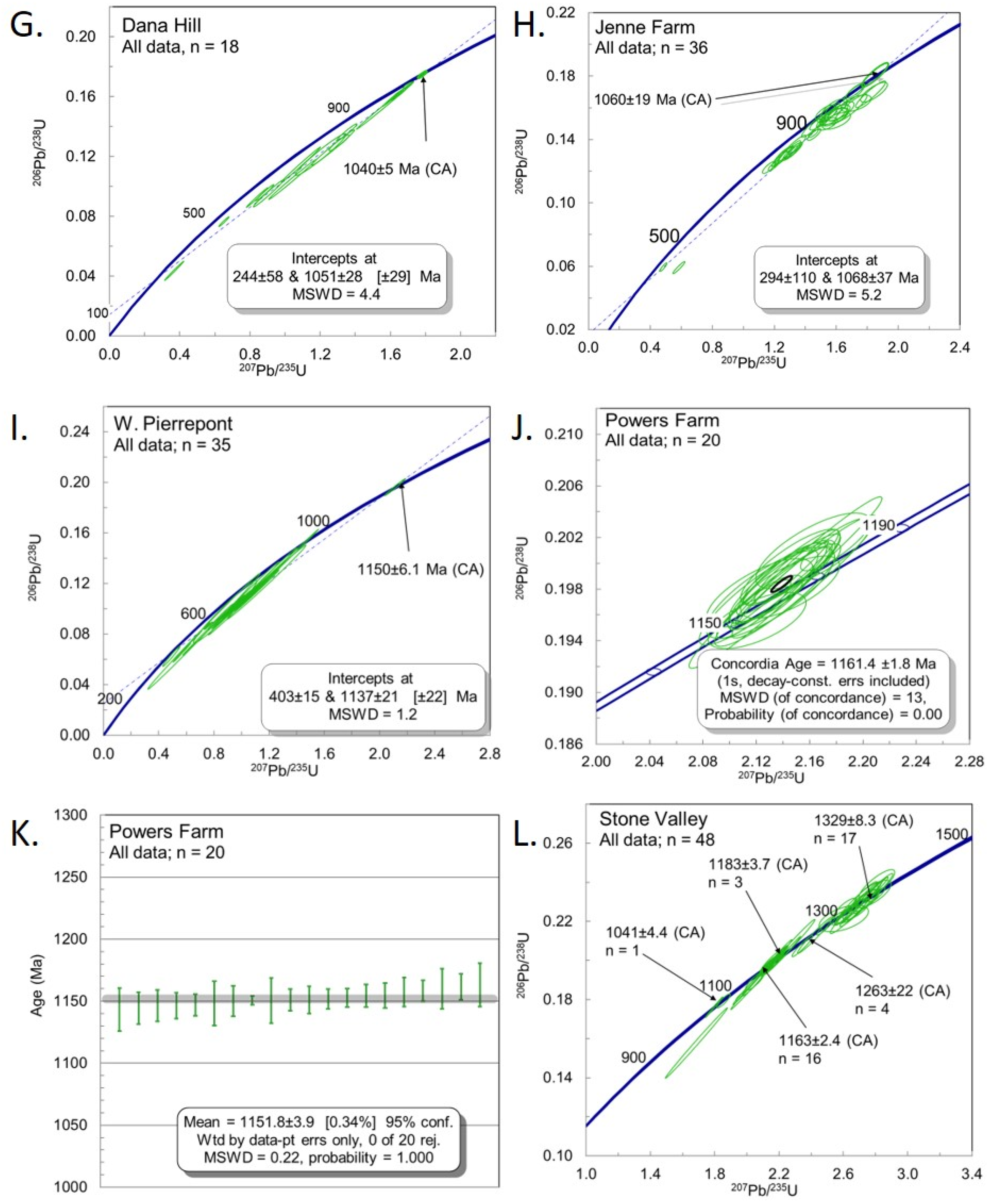
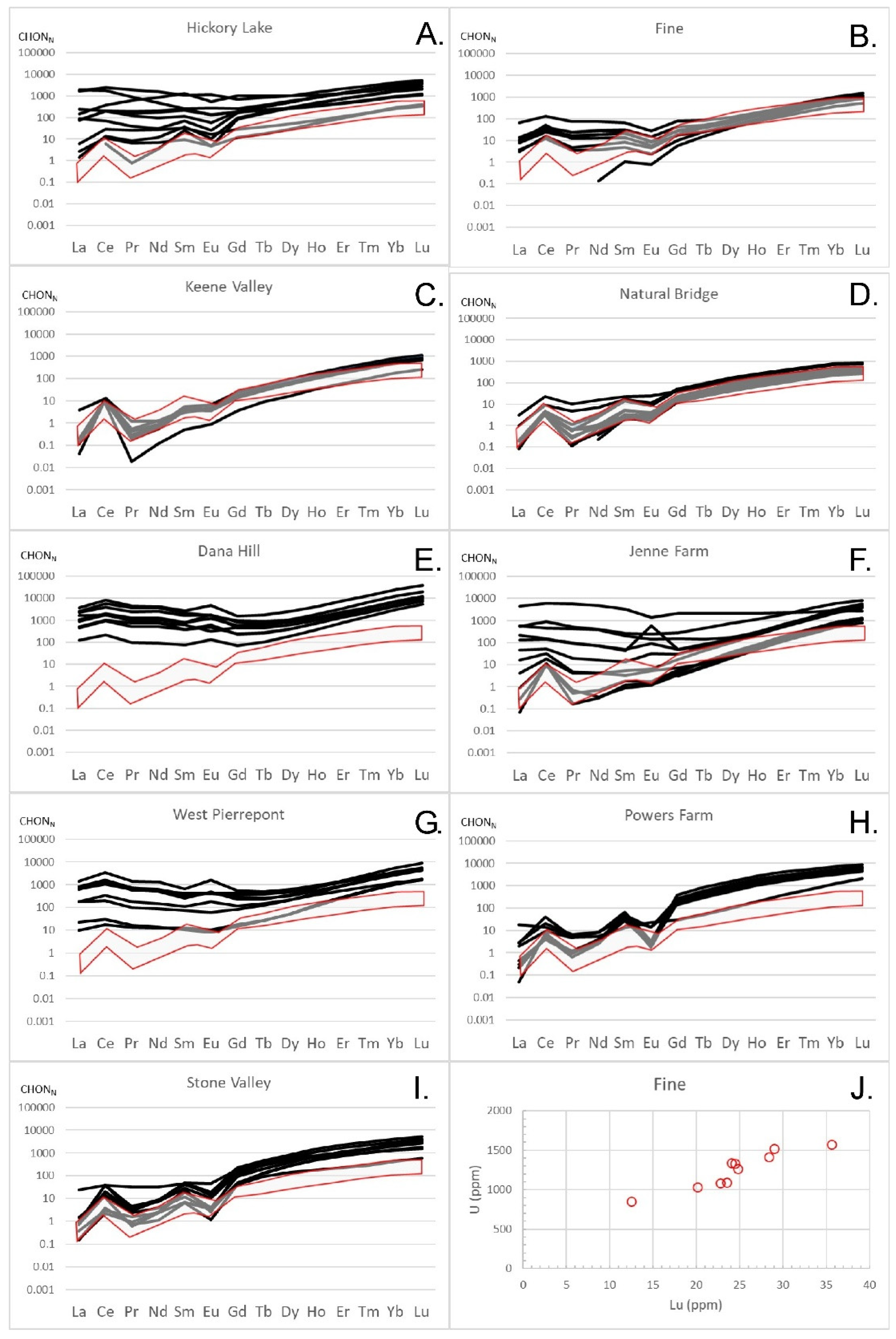
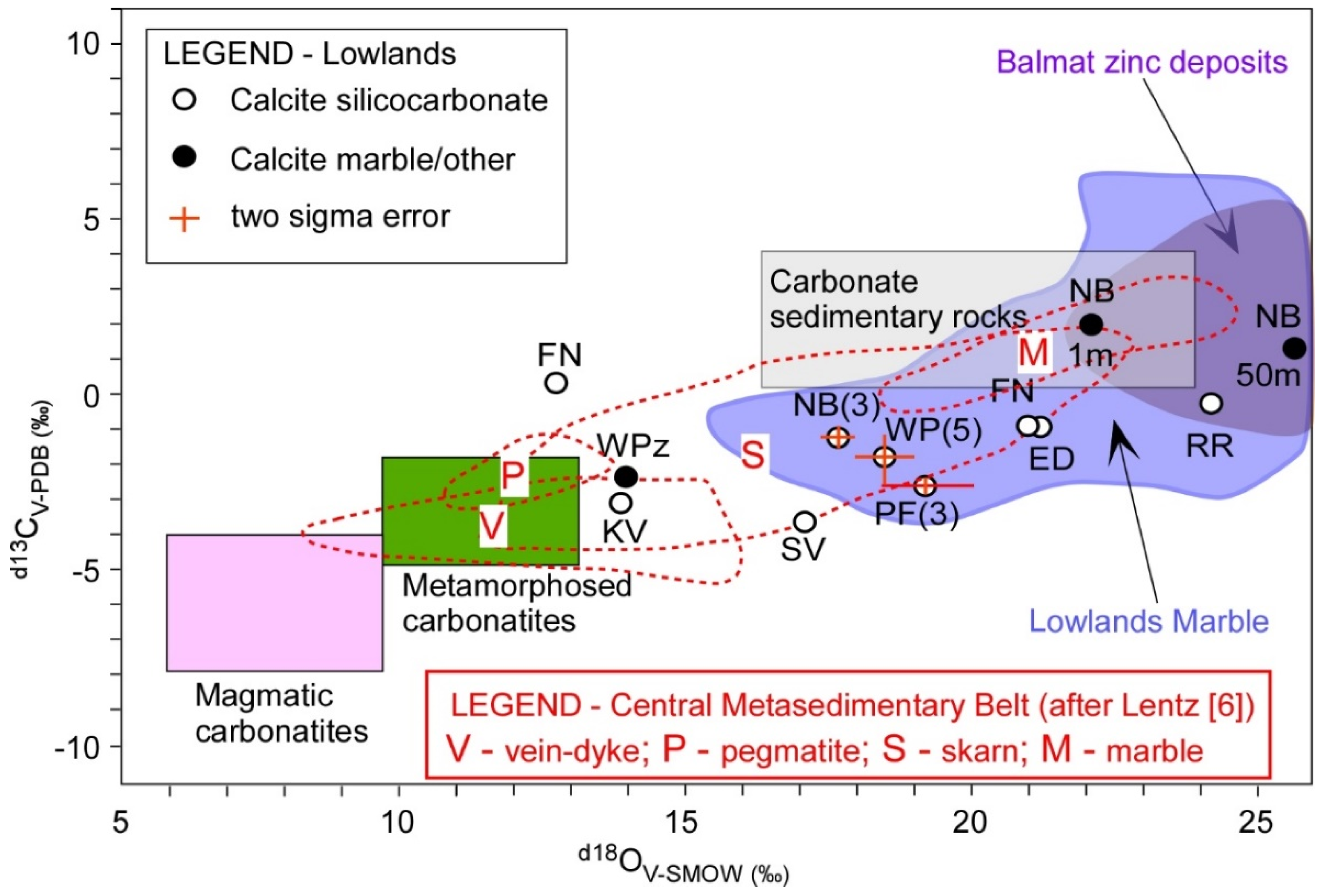
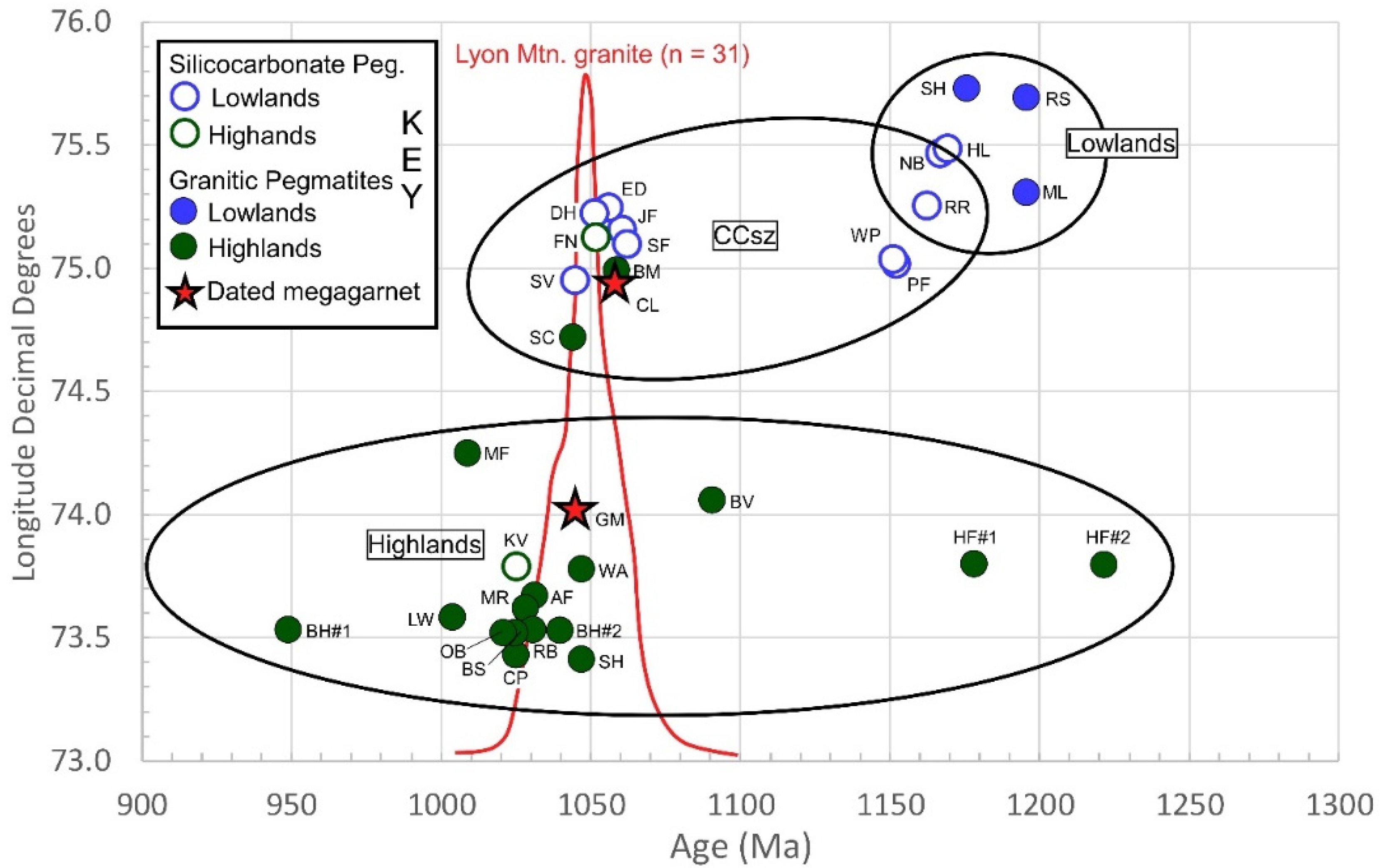
| Sample Nameb (Abbreviation) | Lat/Long Decimal ° | Dominant Minerals | Interpreted Age (Ma) |
|---|---|---|---|
| Lowlands | |||
| Hickory Lake (HL) | 44.465–75.493° | Tur–Ab–Scp–Bt–Dan | 1168 ± 2.8 |
| Highlands | |||
| Fine (FN) | 44.247–75.135° | Kfs–Cal–Hd–Ap | 1049 ± 4.6 |
| Keene Valley (KV) | 44.222–73.791° | Scp–Hd–Cal–Ttn | 1025 ± 1.7 |
| Along Carthage-Colton shear zone (SW to NE) | |||
| Natural Bridge (NB) | 44.074–75.473° | Tr–Di–Kfs–Ttn–Wo–Cal | 1168 ± 7.6 |
| Rose Road (RR) | 44.200–75.233° | Ab–Di–Ttn–Wo–Ap | 1163 ± 20 |
| Edwards (ED) | 44.316–75.240° | Di–Cal–Bt–Phl | 1056 ± 3.7 |
| Dana Hill (DH) | 44.369–75.187° | Di–Dan–Cal–Qtz | 1040 ± 5.0 |
| Jenne Farm (JH) | 44.418–75.155° | Tr–Cal | 1060 ± 19 |
| W. Pierrepont (WP) | 44.491–75.037° | Tr–Di–Cal–Tur–Bt–Scp | 1151 ± 6 |
| Powers Farm (PF) | 44.556–75.021° | Di–Act–Phl–Qtz–Cal–Tur | 1152 ± 3.9 |
| Stone Valley (SV) | 44.573–74.950° | Di–Cal–Ksp | 1041 ± 4.4 |
| Sample | Number (Comment) | Age (Ma) 1 | MSWD 2 | U (ppm) | U/Th Ratio |
|---|---|---|---|---|---|
| Dana Hill (DH) | 18 (all) | 1051 ± 28 UI | 4.4 | 1128 ± 368 | 13.1 ± 3.6 |
| 1 (99.6%) | 1040 ± 5 CA | 0.13 | 879 | 9.5 | |
| 6 (>90 conc.) | 1035 ± 5.9 WA | 0.53 | 876 ± 34 | 9.5 ± 0.5 | |
| Edwards (ED) | 4 (group) | 1056 ± 3.7 CA/1055 ± 7.7 WA | 0.35/1.05 | 444 ± 223 | 33.5 ± 7.6 |
| 4 (group) | 1330 ± 5.4 CA/1328 ± 23 WA | 0.51/1.6 | 242 ± 99 | 1.3 ± 0.2 | |
| 3 (group) | 1450 ± 5.9 CA/1449 ± 12 WA | 0.13/0.03 | 179 ± 32 | 1.6 ± 0.2 | |
| 1 (102.3%) | 1516 ± 7.1 CA | 0.56 | 479 | 1.9 | |
| Fine (FN) | 15 (all) | 1054 ± 5.8 UI | 0.34 | 814 ± 119 | 14.6 ± 1.3 |
| 11(>97% conc.) | 1049 ± 4.6 CA/1053 ± 4.6 WA | 1.3/0.49 | 790 ± 115 | 15.1 ± 1.3 | |
| Hickory Lake (HL) | 12 (all) | 1153 ± 22 UI | 7.0 | 675 ± 644 | 9.22 ± 6.4 |
| 6 (group) | 1168 ± 2.8 CA/1170 ± 7.3 WA | 0.22/0.47 | 425 ± 85 | 5.9 ± 1.6 | |
| 3 (group) | 1097 ± 13 CA/1110 ± 31 WA | 6.8/1.9 | 364 ± 132 | 16.6 ± 4.7 | |
| Keene Valley (KV) | 19 | 1025 ± 1.7 CA/1024 ± 10 WA | 0.03/0.15 | 156 ± 35 | 4.6 ± 1.1 |
| 1(94.5% conc.) | 1103 ± 64 7/6 | NA | 170 | 3.8 | |
| Jenne Farm (JF) | 36 | 1068 ± 37 UI | 5.2 | 828 ± 722 | 19.6 ± 15.2 |
| 1 (102.1%) | 1060 ± 19 CA | 0.32 | 1397 | 24.7 | |
| 1 (82.9%) | 1623 ± 27.2 7/6 | NA | 532 | 6.6 | |
| Natural Bridge (NB) | 35 (all) | 1168 ± 7.6 UI | 1.2 | 680 ± 69 | 7.0 ± 1.1 |
| 35 (all) | 1146 ± 2.8 CA/1162 ± 6.9 WA | 30.0/1.2 | 680 ± 69 | 7.0 ± 1.1 | |
| Powers Farm (PF) | 20 (all) | 1152 ± 9.4 UI | 0.23 | 313 ± 115 | 3.5 ± 0.8 |
| 20 (all) | 1161 ± 1.8 CA/1152 ± 3.9 WA | 13/0.22 | 313 ± 115 | 3.5 ± 0.8 | |
| Rose Road (RR) | 4 (group) | 1052 ± 3.7 CA/1045 ± 7.3 WA | 6.0/0.68 | 474 ± 28 | 33.6 ± 0.5 |
| 10 (group) | 1163 ± 20 UI/1172 ± 10 WA | 0.24/0.25 | 121 ± 93 | 1.5 ± 0.8 | |
| 2 (group) | 1376 ± 8.4 CA/1373 ± 19 WA | 0.19/0.29 | 98 ± 5 | 1.1 ± 0.1 | |
| Stone Valley (SV) | 1 (101.5%) | 1041 ± 4.4 CA | 0.07 | 592 | 39.8 |
| 1 (99.4%) | 1066 ± 9.5 CA | 0.11 | 205 | 44.7 | |
| 16 (group) | 1163 ± 2.4 CA/1161 ± 3.8 WA | 0.83/0.38 | 360 ± 76 | 24.2 ± 8.3 | |
| 3 (group) | 1183 ± 3.7 CA/1187 ± 6.7 WA | 2.5/0.77 | 397 ± 92 | 14.9 ± 11.1 | |
| 4 (group) | 1263 ± 22 CA/1262 ± 12 WA | 0.29/1.16 | 227 ± 114 | 2.6 ± 1.4 | |
| 17 (group) | 1329 ± 8.3 CA/1332 ± 8.7 WA | 0.62/1.3 | 134 ± 84 | 1.7 ± 0.6 | |
| W. Pierrepont (WP) | 35 (all) | 1137 ± 21 UI | 1.2 | 1508 ± 582 | 15.6 ± 6.1 |
| 1 (100.4%) | 1150 ± 6.1 CA | 0.03 | 624 | 4.5 |
| Location | n | δ18O | SD | δ13C | SD |
|---|---|---|---|---|---|
| Edwards (ED) | 1 | 20.29 | −0.87 | ||
| Fine (FN) | 1 | 9.94 | 0.27 | ||
| Fine (FN) | 1 | 20.02 | −0.90 | ||
| Keene Valley (KV) | 1 | 11.31 | −2.91 | ||
| Powers Farm (PF) | 3 | 17.85 | 1.62 | −2.42 | 0.30 |
| Natural Bridge (NB) | 3 | 15.94 | 0.45 | −1.13 | 0.03 |
| Natural Bridge marble (1 m) | 1 | 21.38 | 1.73 | ||
| Natural Bridge marble (50 m) | 1 | 25.75 | 1.15 | ||
| Rose Road (RR) | 1 | 23.94 | −0.27 | ||
| Stone Valley (SV) | 1 | 15.20 | −3.35 | ||
| West Pierrepont (WP) | 5 | 16.99 | 1.03 | −1.74 | 0.88 |
| West Pierrepont Zn (WPz) | 1 | 11.45 | −2.219 |
© 2019 by the authors. Licensee MDPI, Basel, Switzerland. This article is an open access article distributed under the terms and conditions of the Creative Commons Attribution (CC BY) license (http://creativecommons.org/licenses/by/4.0/).
Share and Cite
Chiarenzelli, J.; Lupulescu, M.; Robinson, G.; Bailey, D.; Singer, J. Age and Origin of Silicocarbonate Pegmatites of the Adirondack Region. Minerals 2019, 9, 508. https://doi.org/10.3390/min9090508
Chiarenzelli J, Lupulescu M, Robinson G, Bailey D, Singer J. Age and Origin of Silicocarbonate Pegmatites of the Adirondack Region. Minerals. 2019; 9(9):508. https://doi.org/10.3390/min9090508
Chicago/Turabian StyleChiarenzelli, Jeffrey, Marian Lupulescu, George Robinson, David Bailey, and Jared Singer. 2019. "Age and Origin of Silicocarbonate Pegmatites of the Adirondack Region" Minerals 9, no. 9: 508. https://doi.org/10.3390/min9090508
APA StyleChiarenzelli, J., Lupulescu, M., Robinson, G., Bailey, D., & Singer, J. (2019). Age and Origin of Silicocarbonate Pegmatites of the Adirondack Region. Minerals, 9(9), 508. https://doi.org/10.3390/min9090508




